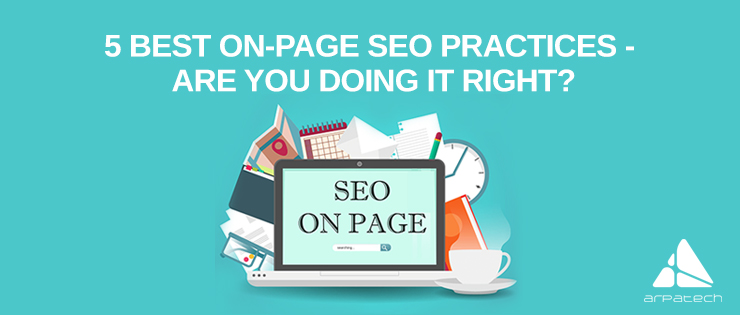5 Best On-page SEO Practices to Boost Your Rankings!

When it comes to good on-page SEO practices, you might have heard about a lot of stuff that might boggle your mind and leaves you confused. But we have listed some really simple and effective SEO on-page practices that are simple and will surely give you a good heads-up in the search results.
So, there are several on-page factors that greatly affects search engine rankings and below we have mentioned the 5 best on-page SEO practices that you need to know. So, let’s get started:
1: Meta Title Tags
Now, before you start writing your Meta Tags, make sure that your keyword research is complete, because keyword research is the most important part in on-page optimization, and you have to make sure that you are targeting the right audience through your keywords. So, if you have done your keyword research, then you can proceed further.
Title tags are the second most important factor in on-page SEO as it tells search engine and visitors what the page is all about. Title tag must be unique for every page.
Code Sample
|
1 2 3 |
<head> <title>Example Title</title> </head> |
Best Practices:
- Suggested format: Your Keyword Base Title | Brand Name
- Use dash or pipe at the end before your brand name
- Keep title tags length between 55 to 60 including spaces
- Do not Repeat Words
- Avoid using duplicate title tags
- Avoid using stop words
Example of a title tag in SERP:

2: Meta Description
Meta Description is the short paragraph or summary of your page. Its content is placed in the head tag of your website. The Meta Description appears under your page’s URL in the search engine results page (SERP).
Example of a Meta Description tag in SERP:

Code Sample
|
1 2 3 |
<head> <meta name="description" content="This is an example of a meta description. That show up in search results."> </head> |
Best Practices:
- Use your most important keywords in the Meta description. Often search engines will highlight in bold where it finds the search query on SERP
- 300 characters is the recommended length, including spaces
- Avoid using duplicate meta descriptions
- Do not use quotes or non-alphanumeric characters (Google cuts off the description)
3: URL
URL or Uniform Resource Locator is human-readable text that was designed to replace the numbers (IP addresses).
Example of a URL in SERP:

Best Practices:
- Recommended Format: http://www.example.com/category-keyword/subcategory-keyword/primary-keyword
- Use Keyword in URL
- Use 80 to 90 characters or try to keep them as short as possible, because research shows that shorter URLs have a higher click-through-rate (CTR)
4: Content with Targeted Keywords
Your page’s content must follow the guidelines laid down by Google. It’s essential that your content is unique and informative for the users and you have to make sure that your content must not repeat in your other pages or is copied from other websites because plagiarism can lead to a serious penalty by Google.
Best Practices:
- Create unique and relevant content
- Use keywords in your content but make sure do not stuff keywords
- Use internal Linking
- Avoid repeating content
5: Internal Page Linking
Internal Links are hyperlinks that lead to other pages in the same domain. In simple words, internal linking is when you link your own website pages in your content.
Internal linking is an important part of on-page SEO because it provides your audience with further reading options and tells the search engines that the page is relevant for that keyword phrases too.
Best Practices:
- Select good anchor text (keywords) rather than Click here.
- Use links that are natural for the reader.
So, we hope that by optimizing your web pages on these parameters, you can surely boost your search engine rankings. If you have any questions, feedback or suggestions, you can comment in the comment sections below:
Latest posts by Moiz Khan (see all)
- How to Use AI to Enhance your SEO Strategies? - August 31, 2023
- What You Need to Know About Test Automation in DevOps - August 30, 2023
- 6 Cloud Computing Challenges That Businesses Need to Be Aware of - August 22, 2023

 Careers
Careers



Pingback: 5 Best On-page SEO Practices to Boost Your Rank...()
Pingback: Benefits Of Using Drupal CMS For Your Website Development()
Pingback: Top Famous Website Designers and their Portfolios()